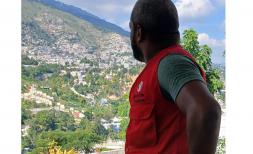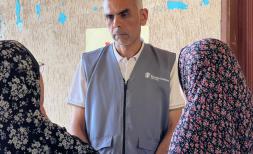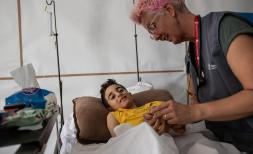STAFF ACCOUNT: The world must not turn its back on the 1 million Rohingya refugees living in Cox’s Bazar
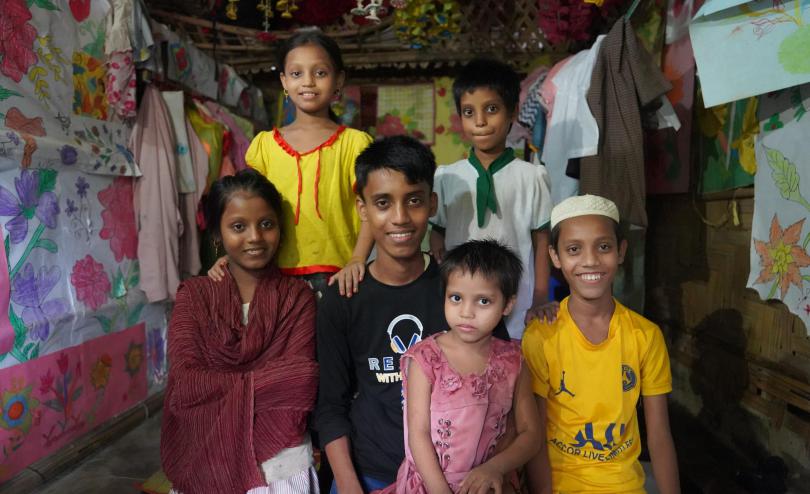
Ayaz, 1, Fahim, 12, Anisa, 11, Salema, 8, Maleka, 6, and Jesmin, 4, posing for a photo in Cox's Bazar, Bangladesh. Saddam Hosen / Save the Children.
Context: In 2017 hundreds of thousands of Rohingya refugees fled violence in Rakhine state in Myanmar to neighbouring Bangladesh. Most ended up in Cox’s Bazar, which was already hosting refugees from previous waves of displacement. Cox’s Bazar is now the world’s largest refugee camp.
In Mahbuba's own words
“I’ve worked on Save the Children’s refugee response in Cox’s Bazar since 2017 and I’ve seen some things getting better for the children in the camps - and some things far worse.
The Rohingya refugee arrivals from 2017 have endured six years of disasters in the camps, including cyclones, floods and landslides. Their shelters are slightly less flimsy than they were in 2017. They are mostly made of bamboo and plastic sheets, so they easily get damaged or destroyed in extreme weather. There have also been many fires over the years, which quickly sweep through people’s homes, which are tightly packed together. It is of course still the world’s largest refugee camp - and it’s still really overcrowded.
The Rohingya refugees were dealt a further blow in February this year when the World Food Programme (WFP) reduced food rations due to funding cuts. It came at a time when food prices were rising in Bangladesh and as a result, many families across the camps are experiencing food insecurity. I’ve spoken to desperate people who can no longer afford nutritious food, such as vegetables and lentils. Meat is out of the question for most. My nutrition colleagues are seeing more cases of malnourished children and pregnant women in recent months than they have for a long time.
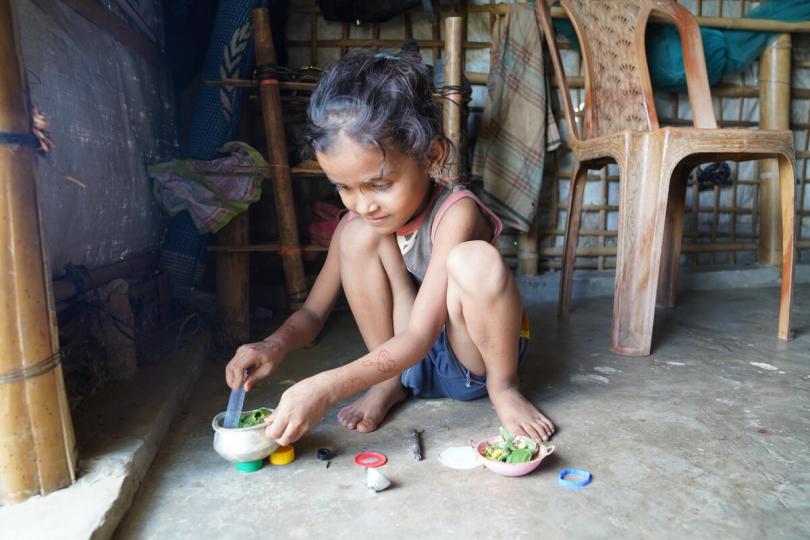
Antora, 5, helps her mother prepare a meal with their food rations in Cox's Bazar, Bangladesh. Rubina Alee / Save the Children.
Faced with such dire circumstances, my team – which is tasked with protecting children from direct harm – is hearing more and more cases of families resorting to dangerous coping mechanisms, such as marrying off their girls before they are of age. Many families see this as having one less mouth to feed when food is scarce. My team is also seeing a concerning rise in cases of child labour. It’s incredibly sad to see children robbed of their childhoods in this way.
Over the past year, there has been an increase in incidences of violence in the camps, including clashes between armed groups. There’s also a marked increase in gender-based violence. There have been cases of gangs raping and sexually abusing Rohingya women, but it’s often not reported.
My colleagues saw an increase in violence in refugee homes during the COVID 19 pandemic when people were quarantining with their families. We are still hearing cases of fathers and husbands becoming hostile and sometimes violent toward their partners and children, and mothers punishing their children more harshly as a negative coping mechanism during the home confinement.
Many children have witnessed or experienced violence themselves. They are understandably upset and afraid. My team provides children with psychological first aid, psychosocial support and counselling, so they can process their experiences in a safe environment. Our social workers/case worker also support women and girls who have experienced sexual violence, as well as supporting them to receive essential health services.
Living in a refugee camp for years on end takes a psychological toll as people face uncertain futures. It’s also difficult for people to depend almost entirely on humanitarian aid.
But that’s not to say that there aren’t any positives to report.
We used to see many cases of children getting lost or going missing. There are now far fewer cases of unaccompanied children as we can use our strong networks across the camps to quickly locate lost children and reunite them with their families.
I’ve personally found that children are now more aware of their rights which is really heartening. They have the skills to speak up and protect themselves from harm. They have a voice and they can say no.
There are also positives in terms of refugees’ resilience in the face of unimaginable adversity.
Refugees aren’t allowed to leave the camps to work outside in the host community, but there is a level of small-scalebusiness in the camps. I’ve seen women gaining confidence to set up small businesses. I know a very young woman who set up a shop beside her house, selling vegetables and snacks.
There’s another young woman whose story stays with me. When she was a child, my colleagues discouraged her parents from arranging a marriage. She’s now 18 years old and a volunteer with a big NGO here. Last week she told me she has been speaking to other families about the dangers of child marriage.
These stories give me some hope, but the humanitarian needs remain truly enormous.
Bangladesh will continue to bear the brunt of the climate crisis, and I fear many more homes and lives will be lost in Cox’s Bazar. Rohingya people are living in appalling and unsafe conditions. Six years on, more funding is desperately needed. The world must not turn its back on the one million Rohingya refugees living in Cox’s Bazar.
--------
Notes
The Rohingya community in Cox’s Bazar is suffering from acute food insecurity, defined as IPC Phase 3 (Crisis) despite the presence of significant assistance. Additionally, the presence of IPC Phase 4 (Emergency) population highlights additional needs and inability to meet their essential needs, according to IPC
95% of all Rohingya households are moderately to highly vulnerable and remain entirely dependent on humanitarian assistance, similar to 2020 (96%), according to 2023 Bangladesh Humanitarian Response Plan
The Global Acute Malnutrition rate for Rohingya refugee children in Bangladesh stands at 12 percent – just below the 15 percent WHO ‘Emergency’ threshold but still categorized as ‘Serious’. Some 40 percent of children have stunted growth and 40 percent of pregnant and breastfeeding women are anaemic - all this is before the World Food Programme food ration cut, according to the World Health Organisation.
Save the Children
Save the Children has been working in Cox’s Bazar since 2012 and increased activities significantly following the 2017 exodus of refugees to Bangladesh with programmes in education, health and nutrition, food, water, shelter and child protection services. Following disasters such as landslides and fires, Save the Children provides emergency assistance to children and their families, including temporary shelter in our learning spaces.
--------
For further enquiries please contact:
- Daphnee Cook Daphnee.cook@savethechildren.org / +254 717 524 904 (in Nairobi)
- Rachel Thompson, Rachel.Thompson@savethechildren.org
Our media out of hours (BST) contact is media@savethechildren.org.uk / +44(0)7831 650409
